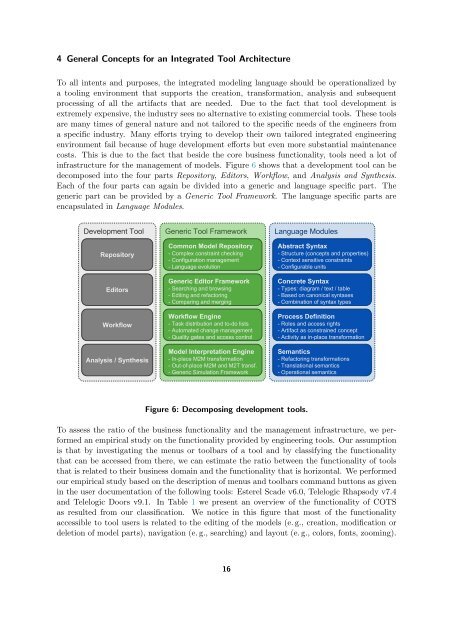SPES 2020 Deliverable 1.4.B-3 Concepts for an Integrated Tool ...
SPES 2020 Deliverable 1.4.B-3 Concepts for an Integrated Tool ...
SPES 2020 Deliverable 1.4.B-3 Concepts for an Integrated Tool ...
Create successful ePaper yourself
Turn your PDF publications into a flip-book with our unique Google optimized e-Paper software.
4 General <strong>Concepts</strong> <strong>for</strong> <strong>an</strong> <strong>Integrated</strong> <strong>Tool</strong> Architecture<br />
To all intents <strong>an</strong>d purposes, the integrated modeling l<strong>an</strong>guage should be operationalized by<br />
a tooling environment that supports the creation, tr<strong>an</strong>s<strong>for</strong>mation, <strong>an</strong>alysis <strong>an</strong>d subsequent<br />
processing of all the artifacts that are needed. Due to the fact that tool development is<br />
extremely expensive, the industry sees no alternative to existing commercial tools. These tools<br />
are m<strong>an</strong>y times of general nature <strong>an</strong>d not tailored to the specific needs of the engineers from<br />
a specific industry. M<strong>an</strong>y ef<strong>for</strong>ts trying to develop their own tailored integrated engineering<br />
environment fail because of huge development ef<strong>for</strong>ts but even more subst<strong>an</strong>tial mainten<strong>an</strong>ce<br />
costs. This is due to the fact that beside the core business functionality, tools need a lot of<br />
infrastructure <strong>for</strong> the m<strong>an</strong>agement of models. Figure 6 shows that a development tool c<strong>an</strong> be<br />
decomposed Technische into Universität the four München parts Repository, Editors, Workflow, <strong>an</strong>d Analysis <strong>an</strong>d Synthesis.<br />
Each of the four parts c<strong>an</strong> again be divided into a generic <strong>an</strong>d l<strong>an</strong>guage specific part. The<br />
generic part c<strong>an</strong> be provided by a Generic <strong>Tool</strong> Framework. The l<strong>an</strong>guage specific parts are<br />
encapsulated Decomposing in L<strong>an</strong>guage Modules. development tools<br />
Development <strong>Tool</strong><br />
Repository<br />
Editors<br />
Workflow<br />
Analysis / Synthesis<br />
Garching,<br />
< DD.<br />
MM.<br />
JJJJ><br />
Generic <strong>Tool</strong> Framework<br />
Common Model Repository<br />
- Complex constraint checking<br />
- Configuration m<strong>an</strong>agement<br />
- L<strong>an</strong>guage evolution<br />
Generic Editor Framework<br />
- Searching <strong>an</strong>d browsing<br />
- Editing <strong>an</strong>d refactoring<br />
- Comparing <strong>an</strong>d merging<br />
Workflow Engine<br />
- Task distribution <strong>an</strong>d to-do lists<br />
- Automated ch<strong>an</strong>ge m<strong>an</strong>agement<br />
- Quality gates <strong>an</strong>d access control<br />
Model Interpretation Engine<br />
- In-place M2M tr<strong>an</strong>s<strong>for</strong>mation<br />
- Out-of-place M2M <strong>an</strong>d M2T tr<strong>an</strong>sf.<br />
- Generic Simulation Framework<br />
L<strong>an</strong>guage Modules<br />
< FIRSTNAME><br />
< LASTNAME><br />
, Chair<br />
IV:<br />
Software<br />
<strong>an</strong>d<br />
Systems<br />
Engineering<br />
Figure 6: Decomposing development tools.<br />
Abstract Syntax<br />
- Structure (concepts <strong>an</strong>d properties)<br />
- Context sensitive constraints<br />
- Configurable units<br />
Concrete Syntax<br />
- Types: diagram / text / table<br />
- Based on c<strong>an</strong>onical syntaxes<br />
- Combination of syntax types<br />
Process Definition<br />
- Roles <strong>an</strong>d access rights<br />
- Artifact as constrained concept<br />
- Activity as in-place tr<strong>an</strong>s<strong>for</strong>mation<br />
Sem<strong>an</strong>tics<br />
- Refactoring tr<strong>an</strong>s<strong>for</strong>mations<br />
- Tr<strong>an</strong>slational sem<strong>an</strong>tics<br />
- Operational sem<strong>an</strong>tics<br />
To assess the ratio of the business functionality <strong>an</strong>d the m<strong>an</strong>agement infrastructure, we per<strong>for</strong>med<br />
<strong>an</strong> empirical study on the functionality provided by engineering tools. Our assumption<br />
is that by investigating the menus or toolbars of a tool <strong>an</strong>d by classifying the functionality<br />
that c<strong>an</strong> be accessed from there, we c<strong>an</strong> estimate the ratio between the functionality of tools<br />
that is related to their business domain <strong>an</strong>d the functionality that is horizontal. We per<strong>for</strong>med<br />
our empirical study based on the description of menus <strong>an</strong>d toolbars comm<strong>an</strong>d buttons as given<br />
in the user documentation of the following tools: Esterel Scade v6.0, Telelogic Rhapsody v7.4<br />
<strong>an</strong>d Telelogic Doors v9.1. In Table 1 we present <strong>an</strong> overview of the functionality of COTS<br />
as resulted from our classification. We notice in this figure that most of the functionality<br />
accessible to tool users is related to the editing of the models (e. g., creation, modification or<br />
deletion of model parts), navigation (e. g., searching) <strong>an</strong>d layout (e. g., colors, fonts, zooming).<br />
16<br />
9
















